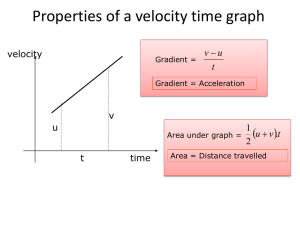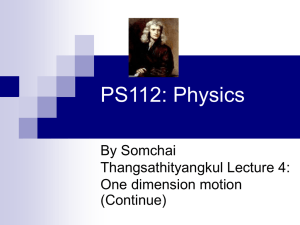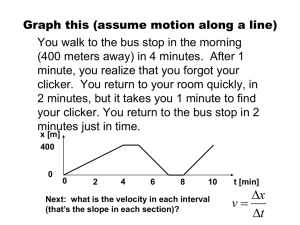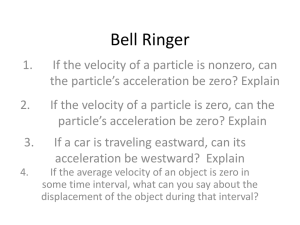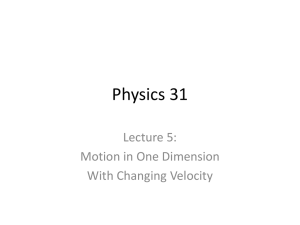Using Calculus in Kinematics The “constant acceleration” equations
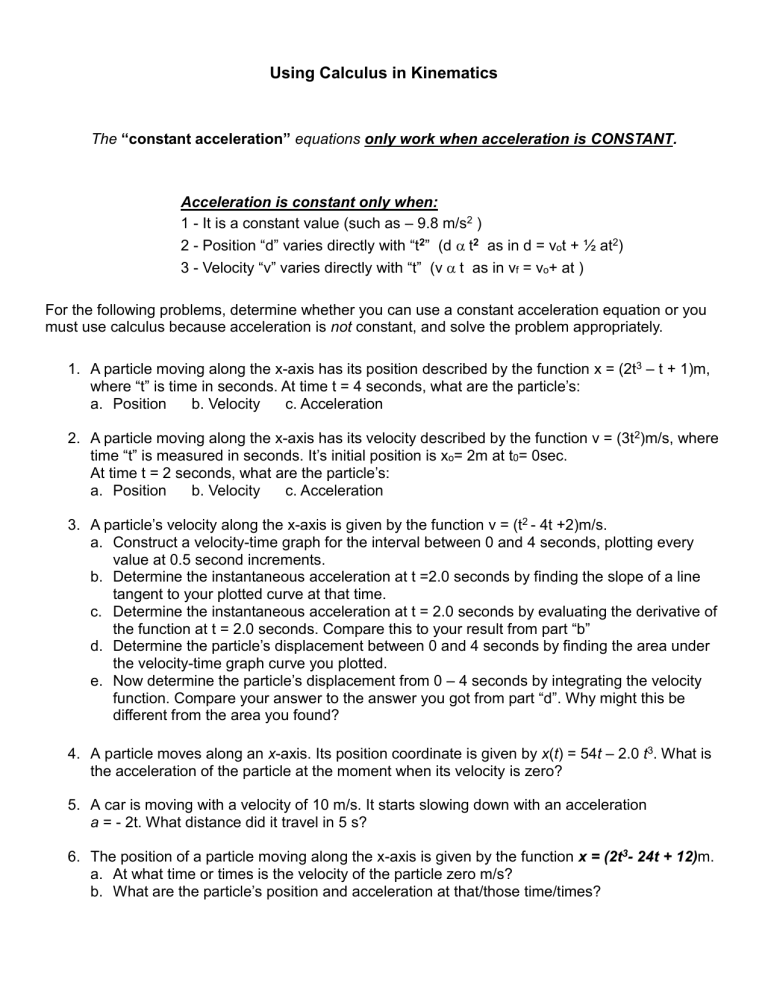
Using Calculus in Kinematics
The “constant acceleration” equations only work when acceleration is CONSTANT.
Acceleration is constant only when:
1 - It is a constant value (such as – 9.8 m/s 2 )
2 - Posit ion “d” varies directly with “t 2 ” (d t 2 as in d = v o t + ½ at 2 )
3 - Velocity “v” varies directly with “t” (v t as in v f
= v o
+ at )
For the following problems, determine whether you can use a constant acceleration equation or you must use calculus because acceleration is not constant, and solve the problem appropriately.
1. A particle moving along the x-axis has its position described by the function x = (2t 3 where “t” is time in seconds. At time t = 4 seconds, what are the particle’s:
– t + 1)m, a. Position b. Velocity c. Acceleration
2. A particle moving along the x-axis has its velocity described by the function v = (3t 2 time “t” is measured in seconds. It’s initial position is x o
= 2m at t
0
= 0sec.
)m/s, where
At time t = 2 seconds, what are the particle’s: a. Position b. Velocity c. Acceleration
3. A particle’s velocity along the x-axis is given by the function v = (t 2 - 4t +2)m/s. a. Construct a velocity-time graph for the interval between 0 and 4 seconds, plotting every value at 0.5 second increments. b. Determine the instantaneous acceleration at t =2.0 seconds by finding the slope of a line tangent to your plotted curve at that time. c. Determine the instantaneous acceleration at t = 2.0 seconds by evaluating the derivative of the function at t = 2.0 seconds. Compare this to your result from p art “b” d. Determine the particle’s displacement between 0 and 4 seconds by finding the area under the velocity-time graph curve you plotted. e. Now determine the particle’s displacement from 0 – 4 seconds by integrating the velocity function. Compare your answe r to the answer you got from part “d”. Why might this be different from the area you found?
4. A particle moves along an x -axis. Its position coordinate is given by x ( t ) = 54 t
– 2.0 t 3 . What is the acceleration of the particle at the moment when its velocity is zero?
5. A car is moving with a velocity of 10 m/s. It starts slowing down with an acceleration a = - 2t. What distance did it travel in 5 s?
6. The position of a particle moving along the x-axis is given by the function x = (2t 3 - 24t + 12) m. a. At what time or times is the velocity of the particle zero m/s? b. What are the particle’s position and acceleration at that/those time/times?
7. An object starts from rest at x = 0m at time t = 0sec. Five seconds later, at t = 5 sec, the object is observed to be at x = 40 m and to have a velocity v x
= 11m/s . a. Was the object’s acceleration uniform (constant) or not? Justify your answer. b. Sketch the velocity-time graph implied by these data. Is the graph a straight line or a curve up or a curve down?
8.
A particle’s velocity is described by the function v x seconds. The particle’s position at t
0
= kt 2 m/s where k is a constant and
= 0 sec is x
0
= -9m, and at t
1
= 3 sec is x
1
= +9m. t is in
Determine the value of the constant k and give its units.
9.
A particle’s acceleration is described by the function a x
= (10
– t) m/s 2 , where t is in seconds.
Its initial conditions are x
0
= 0m, and v
0x
= 0 m/s at t = 0sec.
a. At what time is the velocity again zero? b.
What is the particle’s position at that time?
ANSWERS
1. 125m, 95m/s, 48m/s 2
2. 10 m, 12 m/s, 12 m/s 2
3. 0 m/s 2 , 0 m/s 2 , -1.3 m, -2.6m + C
4. -36m/s 2
5. 8.3 m
6. 2 sec, - 20m , 24m/s 2
7. No. Constant accel. equation doesn’t work. Gives curve down graph
8. K = 2 m/s 3
9. 20 sec, 667 m
